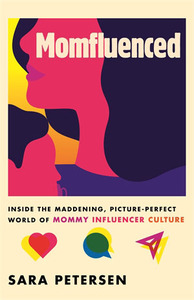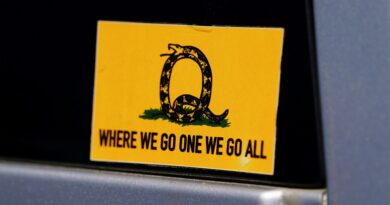On QAnon and the Toxic Longing to Be Part of Something As a Mom
At first, Rebecca Pfeiffer (known on Instagram as Bec @luvbecstyle) seems like a momfluencer type familiar to many. She is a thin white woman with long, beachy waves. On December 3, 2021, Bec posted a photo of herself in a white marble bathroom. She’s wearing a vintage-looking T-shirt, a black beanie topped with a fuzzy pom-pom, black jeans, black Converse sneakers, and a red flannel shirt tied around her waist. The text alongside the photo is standard momfluencer shopping copy:
“This holiday season, I’m committing to far less social gatherings. But I sure luv a cozy night in, getting festive with the kids. 🎄❤Linking these cozy basics that I’m absolutely LUVing and more in my stories & the link in my bio (for anyone still here for this kinda stuff 😉). No seriously? Taking a poll—who’s still actually here for this kinda stuff? ጐ🤣឵Follow my shop @ luvbec on the @shop.LTK app to shop this post and get my exclusive app only content! #liketkit #LTKHoliday #LTKSeasonal #LTKsalealert.”
Nothing to see here, right? Just a momfluencer trying to make a few bucks.
A quick note about her LTK hashtags. LTK stands for “like to know,” and is part of the Rewards Style affiliate marketing program. If you click on Bec’s LTK links, Rewards Style will give her a percentage of any sales made as a result. Rewards Style was one of the first companies that figured out how to make it easy for influencers to link to shoppable content, and they really revolutionized the way we shop for things via Instagram.
I would argue that pairing with a major agency like Rewards Style confers a sense of legitimacy to momfluencers—which might make users more likely to assume other, non-fashion-related content is also legitimate—so it seems relevant to point out in this case.
“Nothing is more important than the children.” Who could ever argue with that?
Only a couple of weeks prior to posting this run-of-the-mill shoppable content, Bec posted a simple infographic. Across a background of baby blue and powder pink reads the hashtag “#whereareallthechildren” popularized, in particular, by QAnon moms. Bec’s post has all the trademarks of a classic QAnon momfluencer post. She confirms her own authority by mentioning how her original post “went viral” by virtue of a hashtag she “created.”
She misspells certain words to get past Instagram’s guidelines against posting dangerous misinformation (see her spelling of “deleting,” “followers,” “fight,” and even “tyrants”). She directs her followers to a backup account, something many conspiracy theorist influencers do as an insurance policy in case their main accounts get flagged by Instagram. And most importantly, Bec draws attention to her motherhood as a moral imperative to be unthinkingly trusted: “Nothing is more important than the children.” Who could ever argue with that?
While there are thousands of viral voices spreading QAnon conspiracy theories online, I’m interested in why mothers in particular have become some of their most visible spokespeople. QAnon is an infamously complicated conspiracy theory, the tentacles of which extend into everything from pizza to Wayfair furniture to movie star cannibalism, but essentially, Q followers believe there is a there is a shadowy cabal of “liberal elites” kidnapping children and trying to overthrow the American government and that Donald Trump spent his presidency trying to thwart them. There is no evidence that any part of this conspiracy theory is true.
QAnon has often been associated with un–aesthetically pleasing men who yell a lot. Not exactly momfluencer territory, which is famously aesthetically driven. Pastel pink infographics, flowers, golden hour glows—not poorly lit 4Chan videos featuring abrasive, loud men. But, as we’ve seen with Bec, mothers (white mothers in particular) have successfully repackaged Q to appeal to regular moms who also might want to buy a cute beanie with a floofy poof on top.
In an article for Elle, Anne Helen Petersen tracks how conspiracy theorists’ co-opting of hashtags took place because of social media platforms’ initial crackdowns on misinformation. #SavetheChildren, for example, prior to being taken up by QAnon conspiracists, was once a legitimate hashtag created by a child welfare organization.
Petersen writes that the appropriation of new hashtags that initially seem innocuous and altruistic “inadvertently created a new radicalization pipeline around #SavetheChildren, which circulated freely in the aesthetically pleasing, female-dominated corners of the internet, appealing to moms who, amid the upheaval of the pandemic, just wanted something to believe in.”
I deeply understand and empathize with this longing to both be a part of something and to believe in something worth being a part of. Because of the politically and culturally disempowered role many mothers play in our culture, we are specifically vulnerable to groups and messages that promise a sense of purpose, promise us something that feels bigger than reminding our kids to do their homework or eat their vegetables.
In her piece for Elle, Petersen points out, of course, that white women might look elsewhere for causes to join or work for, but she thinks the reason white women are less likely to participate in the Black Lives Matter movement, or start canvassing for local politicians, or donate their time to Planned Parenthood, is due to a fear of politicism. Referring to Black Lives Matters specifically, Petersen writes:
“But many of them disagree with its goals, like defunding the police, or don’t think of themselves as ‘political,’ a word that’s often used as a placeholder for ‘someone who talks about race.’ They’re faced with few options: put up ‘Blue Lives Matter’ or ‘All Lives Matter’ yard signs, which still doesn’t feel like a movement, or remain silent. And that silence, especially for white women used to having their voices heard and respected—used to being included—can feel like suffocation.”
There’s another reason white momfluencers might be more likely to spread Q conspiracies or preach about “toxin-riddled” vaccines than to align themselves with a conventional social justice or political group, and that has to do with motherhood. The implied moral goodness of (white) motherhood allows them to easily latch onto Q’s fear mongering specifically related to harm toward children.
After interviewing attendees of a “Freedom for the Children” QAnon-centric rally in London for a New York Times article about motherhood and QAnon, Annie Kelly determined that maternal protectiveness was at the root of many white mothers’ participation. “Very few brought up QAnon’s connections with President Trump, Hillary Clinton or the anonymous 4chan account known as ‘Q’ that started it all,” she writes. “They were here, they said, for the children.”
Kelly explains that the nature of our social media landscape is critical to understanding not only the appeal of QAnon but also the ease with which it spreads among mothers who have been traditionally restrained from access to male-only conspiracy groups. As Kelly notes, “QAnon, by contrast, has looked for converts anywhere it can find them, making the slogan ‘where we go one we go all’ (usually abbreviated to the hashtag #WWG1WGA) its rallying cry.”
And if QAnon is looking for moms, what better place to find them than on Instagram, where, according to Instagram’s own data, 93% of American mothers consume and share content if not daily, then weekly.
Because the vast majority of the most well known, financially successful momfluencers are still predominantly white, it also makes sense that QAnon would seek out white momfluencers to spread misinformation and fear-mongering infographics. While QAnon has long been associated with anti-Semitism, Mia Bloom, while researching her book Pastels and Pedophiles: Inside the Mind of QAnon, found that racism is also integral to the group’s messaging.
Out of 240 QAnon images paired with #savethechildren messages on social media, Bloom and her research team discovered that despite the fact that “the vast majority of children who are trafficked originate from the global south … the images of the children in the QAnon campaigns were almost uniformly white, usually female, and often badly bruised, bound, or bleeding.”
The reasoning, according to Bloom, is that images of white children would appeal to white moms in a way that images of children of color would not.
Bloom also found that while the child in these images was white the vast majority of the time, the adult hand was Black or brown 90 percent of the time, leaning into age-old racist stereotypes vilifying Black and brown men as inherently violent and predatory.
It’s easy to label moms trafficking in conspiracy theories as silly or crazy, but doing so not only negates their very real influence and power, it also prevents us from understanding what drives white moms to Q and the alt-right in the first place.
White women are not just responsible for literally perpetuating the white race; white mothers are responsible for instilling white supremacist ideology in their children.
As someone who spent her first few years of motherhood solely devoted to childcare and domestic work, I understand wanting and needing something more. Care and domestic work is critical to capitalism (and more importantly, to life!), but because many mothers and care workers don’t earn wages for that work, our work is denigrated as less than. We don’t earn bonuses. We don’t receive external praise. There are no “40 Under 40” lists celebrating our accomplishments.
The fact that social media allows “regular moms” to find an audience for their ideas and even make a bit of money on the side from their affiliate links and sponsored content while also participating in something that feels bigger and maybe more important than their own daily lives allows for mothers to spread awareness about just about every cause under the sun.
Whether momfluencers are posting about paid leave, equitable workplace opportunities, or, as in the case of Bec, harmful conspiracy theories which vilify marginalized communities, they all typically back up their beliefs with their maternal morality.
QAnon followers and white nationalists also understand the value of maternal influence and labor in ways many mainstream organizations do not, which is in keeping with white supremacist groups from history, which have long recognized white motherhood as playing a critical role in hate movements. White women are not just responsible for literally perpetuating the white race; white mothers are responsible for instilling white supremacist ideology in their children, ensuring that white supremacy lives on in the next generation.
And, given the gaslit reality of motherhood in America, where we are celebrated for our supposedly innate maternal goodness while wholly unsupported in meaningful, structural ways, it’s not entirely surprising that a movement that gives mothers plenty of laudatory lip service paired with the illusion of power might prove enticing.
While moms disseminating Q and other conspiracy theories might not be directly financially compensated for their work, I do think they gain cultural capital by upholding their own status as authorities, “truth-tellers,” and maverick thinkers eager to “do their own research” and share it with their followers. I wonder how susceptible these mothers might be to the murky promise of external validation in the form of likes if they were granted the same cultural respect for their work, as, for example, doctors and lawyers.
We’re all told motherhood is the most important job in the world, but if a mother devotes herself entirely to childcare and domestic labor, she will not get paid for that “most important job” nor will she even be able to sustain much more than a pleasant nod at a cocktail party when she tells a fellow guest about her work.
__________________________________

Adapted from Momfluenced: Inside the Maddening, Picture-Perfect World of Mommy Influencer Culture by Sara Petersen (Beacon Press, 2023). Reprinted with permission from Beacon Press.
This article has been archived for your research. The original version from Literary Hub can be found here.


